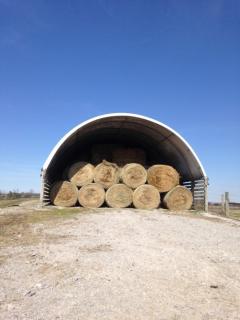Producing Quality Hay
 Hay is the most commonly stored forage on most Kentucky farms. Since hay is widely utilized, understanding the factors that affect the quality of hay is important, as well as how to produce high quality hay. The ultimate test of hay quality is animal performance. Hay must be palatable to be consumed in adequate amounts, and provide ample amounts of energy and other nutrients.
Hay is the most commonly stored forage on most Kentucky farms. Since hay is widely utilized, understanding the factors that affect the quality of hay is important, as well as how to produce high quality hay. The ultimate test of hay quality is animal performance. Hay must be palatable to be consumed in adequate amounts, and provide ample amounts of energy and other nutrients.
Factors Affecting Hay Quality
Stage of Maturity when Harvested
Maturity stage is the most important factor impacting forage quality and the easiest way to significantly improve quality. As grasses and legumes advance from the vegetative (leafy) to reproductive (seed) stage, they become higher in fiber and lignin content and lower in protein content, digestibility, and acceptability by livestock. Making the first hay cutting early permits re-growth to begin at a time when temperatures and soil moisture are favorable for plant growth. This will generally increase the total yield per acre over the course of the year even though first cutting yield will be lower.
Curing and Handling Conditions
Poor weather (i.e. rain, hail) and handling conditions can lower hay quality. Rain can cause leaf loss and can leach nutrients from the plants. Sunlight can lower hay quality by bleaching and lowering Vitamin A content. To reduce leaf loss, rake or ted hay while it is moist (above 40% moisture) and avoid baling when it is too dry (15% moisture or less). A good rule is to ted hay later than 7 p.m. the afternoon it was cut, or before 10 a.m. the day after cutting. To reduce drying time and help decrease damage, use wider swaths.
Hay Preservatives
Hay can be safely baled around 20% moisture (small bales) and 18% (large bales) with the correct preservative at baling. These preservatives will prevent excessive heating and mold growth. The most common type of preservative in Kentucky is some form of propionic acid.
Storage
Storing twine-tied hay bales outside unprotected can result in losses exceeding one-third of the original crop. Plastic mesh wrap (net wrap) and solid, self-adhesive plastic wrap are recent developments in round bale storage that can provide some extra protection against weather conditions during outside storage. Storing inside or under a roof is recommended to preserve the hay better. Even when stored in dry conditions, hay will lose nutrients over time. Research has shown that the dry matter loss for twine bales averages around 6% for inside storage, while bales stored outside can have losses approaching 35%.
Soil Fertility
- Adequate amounts of lime, nitrogen, phosphate, potash and minor elements are needed to produce high yields of hay per acre. These nutrients are also essential when maintaining a stand of desirable plants for a long period of time.
- High yields of hay remove large amounts of nutrients with each cutting.
- Soil testing should be used to determine the amount of fertilizer and lime that are required for high yield and economical production.
Plant Species/Varieties
- Legumes are normally higher in quality than grasses, but within each group there can be a wide range of quality. Both should be harvested at the proper stage of plant growth for best quality.
- Plant certified seed of improved varieties that have been tested under local conditions. Improved varieties will generally create a better stand that lasts longer than common uncertified seed. More information on seed and forage varieties.
- Seed at the recommended rates and dates to enhance the odds of getting the best stand possible.
Producing quality hay will help keep adequate cattle body condition and growth during times when pastures are not growing. Feeding low quality hay can negatively impact cattle body condition, immune system, and weight gain. By feeding growing cattle low quality hay, they will take longer to get to a desired selling weight, which will decrease the profit from each animal. For more information, see UK publication AGR-62: Quality Hay Production.
Table 1. Grazing Heights for Forages Common in Kentucky
| Plant Species | Time of Harvest |
|---|---|
| Alfalfa | Late bud to first flower for first cutting, first flower to 1/10 bloom for second and later cuttings |
| Tall Fescue, Orchardgrass, KY Bluegrass | Boot to early head stage for first cut, aftermath cuts at 4-6 week intervals |
| Red Clover, or Crimson Clover | First flower to 1/10 bloom |
| Cereal Rye and Triticale | Boot stage or before |
| Wheat | Boot to early heading stage |
| Sudangrass, Pearl Millet, Sorghum Hybrids | 40-inch height or early boot stage, whichever comes first |
Categories:
Spring
Extending the Grazing Season


